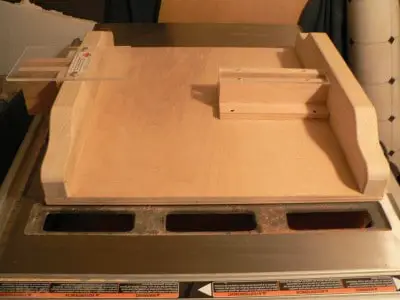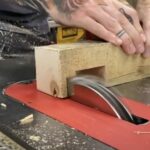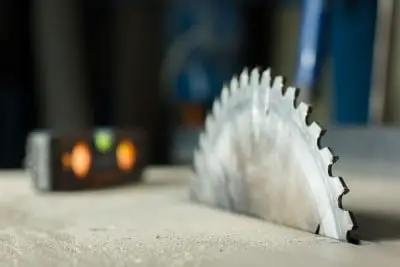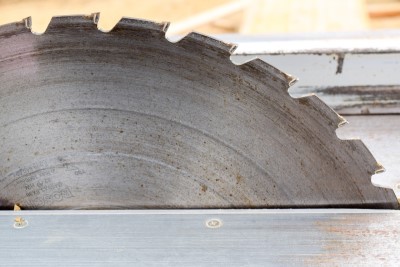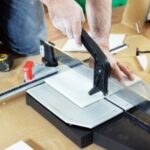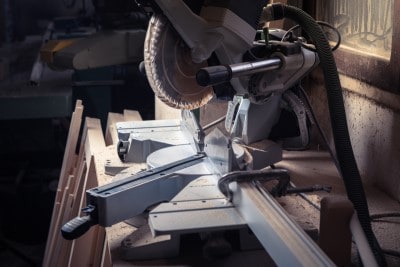One of the most important things about a tool- especially an expensive one- is versatility. Miter saws are ideal for making angled cuts, but are angled cuts all that they are meant for?
Although primarily designed to cut at an angle, miter saws can consistently make perfectly straight cuts in wood of various widths. While there are a few situations where other tools may be a better fit, the miter saw is a great tool to use when you need to make crosscuts with extreme precision.
Miter saws are a workshop staple for woodworkers of all skill sets. Now, let’s go in-depth with miter saws- what they are, how they work, and how they compare to other common power saws used by woodworkers.
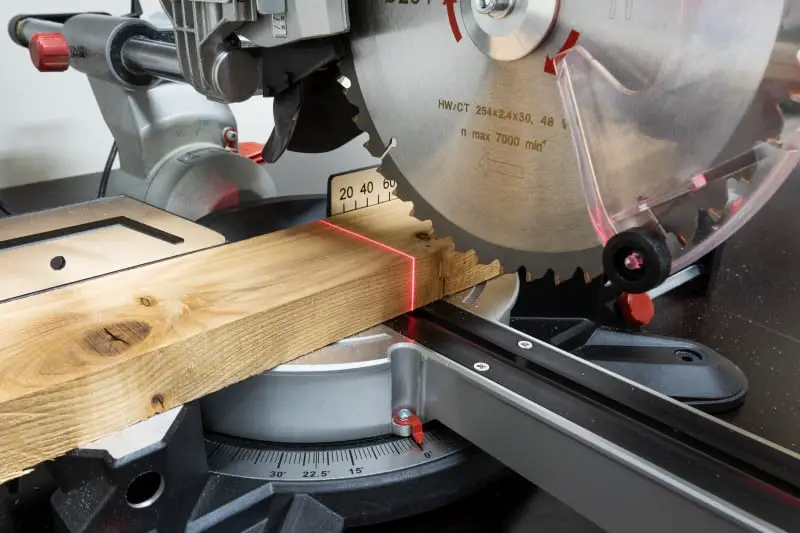
What is a Miter Saw?
Miter saws as we know them today were invented in the 1960’s, and they are used to make-you guessed it- miter cuts, which are angled cuts that allow two pieces of wood to be joined together, most often at right angles. Before the modern miter saw was developed, these cuts were made using a miter box which guided a hand saw at the correct angle.
Miter boxes, in addition to lacking the ease of use that power tools provide, also weren’t very versatile. The modern miter saw is extremely versatile, and is an indispensable tool for many woodworkers.
Miter saws are used by woodworkers and construction workers to join wood with perfect, almost invisible seams. Joining wood is one of the trickiest parts of woodworking; it’s such a daunting task that many beginner woodworkers avoid any projects that require it.
Having a miter saw (and knowing how to use it) makes wood joining a whole lot easier. You still have to know joining techniques, but that’s another subject for another day. Suffice it to say, miter saws are pretty much indispensable for many fine woodworking projects.
Read more: Are Miter Saws Dangerous
How Do Miter Saws Work?
Miter saws are essentially circular saws suspended above the workpiece by a spring loaded arm, lowered onto the workpiece to make the cut. The arm and saw are on a half-circle track that can be adjusted to any angle (relative to the fence, where the workpiece is placed).
Want a 45 degree cut to join two pieces at a 90 degree angle? Simply set the blade to 45 degrees, make your cuts, and you’ve got two perfectly matched pieces to join!
Making a Miter Cut, Explained
The key to using a miter saw is just a little bit of math. If you want to join two pieces at a 90 degree angle, you cut at 45 degrees because they’ll add up to 90. If you want two pieces to join at a 135 degree angle, you cut both of them at 22.5 degrees.
Why is that? It all goes back to grade school geometry class. You take the angle you want to create and subtract that from 180. Then, you divide that number by two- and the final result is the angle you want to cut at. Here’s an example of the formula for joining two pieces at a 135 degree angle:
180 -135 = 45
45 / 2 = 22.5
All of the angles need to add up to 180 degrees, just like using a protractor. Each cut, and the “negative” space on the other side of the angle up a half circle- 180 degrees. When the math is correct, you will be able to join wood at any angle you like.
Making a Straight Cut (Crosscut)
It’s a reasonable but incorrect assumption: thinking that miter saws, since they are designed for angled cuts, won’t cut straight. In reality, Miter saws can make cuts at any angle from 0-179 degrees.
If you need to make a clean, perfect cut to shorten a board or piece of lumber, miter saws are a wonderful option. Simply set the angle to 90- that will set the saw perpendicular to the fence. This will mean that the cut is perfectly straight, all the way across the workpiece.
Oh, and by the way, the word “crosscut” is a widely used term for straight cuts. The reason for this is because straight cuts are typically made across the grain of the board. Not necessary knowledge, but, hey, if you can sound like a veteran woodworker, why not?
MIter Saws Compared to Other Saws
Table Saws
Table saws often get confused with miter saws, because they’re both large saws with circular blades that are used on a tabletop. Table saws, like miter saws, can also be used to make crosscuts. The key differences, however, come from their individual purposes.
Table saws are designed to rip cut long boards and shave precise amounts from the long edge of a board. Additionally, table saws have different mechanics; you push the wood through the blade, rather than running the blade through stationary wood a la miter/circular saws.
Finally, table saws aren’t known for portability. Miter saws, however, aren’t light, but they’re light enough to be taken to a jobsite and back, and portable stands can accompany them.
Circular Saws
Circular saws are designed to make rip cuts on sheets of plywood, quick cuts on boards, and serve as a fast go-to tool on job sites and projects that don’t require high levels of precision. While it is true that you can make angled, miter-style cuts with a circular saw, it’s nearly impossible to guarantee they’ll have the same kind of accuracy and smooth finish you would see with a miter saw.
In fact, it’s kind of an all-around horrible idea to ignore a miter saw if you have one!
The same can be said for making straight cuts with a circular saw. With a two-by-four, it isn’t too hard to make a cut very straight, but anything longer usually results in wavering, curved lines.
There are tools such as the Kreg Rip Cut that will solve this problem, which is great. However, circular saws just aren’t meant for the type of precision that table saws and miter saws are. They’re a wonderful tool for many jobs, but a bit rough and unrefined.
When/When Not to Use a Miter Saw
There are two reasons you would use a miter saw. The first, obviously, is to cut wood that you are going to join at an angle, such as for a picture frame or furniture legs. This is the reason miter saws exist- to make this work as easy and as accurate as it can possibly be. These cuts are the first and arguably most important step of wood joining; miter saws get you started on the right track.
The second reason would be if you want to make sure that your crosscuts are exactly the right length. Think about a rectangular tabletop- each board needs to be exactly the same length, the first time- or you’re going to have a boatload of extra work on your hands fixing the errors.
When would a miter saw be a bad option? When it’s overkill, for one. Yes, the cuts will be prettier, but if precision isn’t necessary, a circular saw is going to be all you need, and they’re faster.
Another factor that makes a miter saw a bad choice is the width of the wood. If you’re cutting plywood or slabs of live edge wood, miter saws are a waste of time. Table saws are really the only option when dealing with that kind of material.
Tips and Best Practices for the Best Crosscuts
Miter saws are precision tools, fully adjustable to your needs. However, you would have to be pretty lucky to buy a miter saw, plug it in, and get perfect cuts right off the bat. Here are a few tips to optimize the accuracy of your crosscuts.
- Test your crosscuts before using the actual project material. Cut two pieces of wood and hold the edges up together. Is there a gap present where there shouldn’t be when you hold the edges together? That’s a good indicator that you need to adjust the saw according to manufacturer instructions
- Clamp your wood whenever possible. Miter saws, just like any powered saw, can have a tendency to grip the wood and pull it ever so slightly. That can ruin the cut (this happens even more with bevel cuts, because the fence doesn’t provide as much support). While you may not always truly need to, it’s wise to clamp the wood whenever possible to avoid wasting it.
- Keep your blades sharp and clean. This is always good advice, no matter the tool. The better you take care of it, the better it will perform for you. Having sharp blades, in addition to providing the cleanest cuts, also help you avoid those gripping and pulling issues. Consider it a bit of added protection.
- Know the width of your blade. All saw blades have a certain width, and you should accommodate for this, because you may end up with shorter pieces than you wanted. For example, if your blade is 1/16 of an inch wide, you should add that amount to the measurement before you cut. That way, after the cut, you will have the exact length you need!
Conclusion: Can a Miter Saw Cut Straight?
Miter saws are wonderful, precise tools that save time and headaches on woodworking projects. Although they are designed primarily to make angled “miter” cuts, miter saws can crosscut with accuracy and ease. If your next woodworking project calls for crosscutting- consider using a miter saw to get the cleanest, most accurate cut!
Read more:

